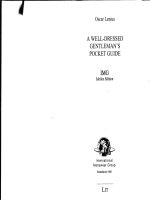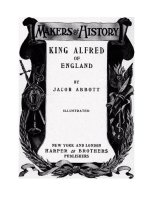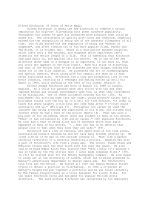Paul duncan alfred hitchcock pocket essential
Bạn đang xem bản rút gọn của tài liệu. Xem và tải ngay bản đầy đủ của tài liệu tại đây (1.06 MB, 160 trang )
Hitchcock
16/7/04
8:20 am
Page 2
Other titles in this series by the same author
Film Noir
Hong Kong's Heroic Bloodshed (Ed.)
Martin Scorsese
Noir Fiction
Orson Welles
Stanley Kubrick
Woody Allen
Hitchcock
16/7/04
8:20 am
Page 3
Alfred Hitchcock
Paul Duncan
www.pocketessentials.com
Hitchcock
16/7/04
8:20 am
Page 4
This edition published in July 2004 by Pocket Essentials,
P. O. Box 394, Harpenden, Herts, AL5 1JX
Distributed in the USA by Trafalgar Square Publishing,
PO Box 257, Howe Hill Road, North Pomfret,Vermont 05053
© Paul Duncan 2004
The right of Paul Duncan to be identified as author of this work
has been asserted by him in accordance with the Copyright, Designs &
Patents Act 1988.
All rights reserved. No part of this book may be reproduced, stored in or
introduced into a retrieval system, or transmitted, in any form or by any
means (electronic, mechanical, photocopying, recording or otherwise)
without the written permission of the publishers.
Any person who does any unauthorised act in relation to this publication
may be liable to criminal prosecution and civil claims for damages.
A CIP catalogue record for this book is available from the British
Library.
ISBN 1 903047 00 5
2 4 6 8 10 9 7 5 3 1
Typography by Avocet Typeset, Chilton, Aylesbury, Bucks
Printed and bound in Great Britain by Cox & Wyman, Reading, Berks
Hitchcock
6/7/04
1:58 pm
Page 5
for Claude and Josef
Hitchcock
6/7/04
1:58 pm
Page 6
Acknowledgements
For their help filling gaps in my video, book and clippings
collection, and for ideas, I would like to thank John
Ashbrook, Colin Odell, Michelle LeBlanc, Ellen Cheshire
and John Kennedy Melling. For his encouragement,
thanks to Hitchcock admirer Ed Gorman. For inspiring
me, thanks to Claude and Josef.
Hitchcock
6/7/04
1:58 pm
Page 7
Contents
Alfred Hitchcock: Inspiring Public Unease
An introduction to the life and work of the
Master of Suspense
9
1. Silent Hitchcock (1922-1929)
Early work in silent cinema, including
The Lodger
21
2. The Mastermind Returns (1929-1939)
The first British talkie, Blackmail, and the
great Man On The Run films of the 1930s
31
3. Lost In America (1940-1947)
Establishing his American credentials with
Rebecca, Shadow Of A Doubt and Notorious
67
4. Breaking Free (1948-1949)
Independence at a price with Rope and
Under Capricorn
101
5. On A Roll (1950-1954)
Getting his act together with Strangers
On A Train, I Confess and Dial M For Murder
107
Hitchcock
6/7/04
1:58 pm
Page 8
CONTENTS
6. Auteur Theory (1954-1960)
Fame and fortune achieved with Rear
Window, To Catch A Thief, Vertigo, North
By Northwest and Psycho
117
7. Beyond The Frame (1963-1976)
Losing the plot with The Birds, Marnie
and Frenzy
139
Reference Materials
Books and Websites where you can find out more
155
Hitchcock
6/7/04
1:58 pm
Page 9
Alfred Hitchcock:
Inspiring Public Unease
I had a dream once. I’m at LAX (Los Angeles airport) and
I’m waiting for my case to slide down the chute.There are
lots and lots of people milling about.They are nondescript.
I see my case on the carousel, pick it up and roll it towards
Customs. I’ve got drink to declare but, before I get there, I
trip on my laces.A Customs man walks towards me, asks if
everything is okay. I’m fine. I crouch to tie my laces. He
picks up my case and dusts it off. As he does so, I look at
my case and realise it is not mine. My heart misses a beat.
Looking at my face, the Customs man realises something’s wrong. He asks me to accompany him to his desk.
I pause, then get up. Slowly, I walk towards his table,
watching him unlock the case, open it. I can only see his
eyes look down, then look up at me.“Is this your case, sir?”
he asks me. I wake up in dread. What was in that case? I
knew it was something bad.
Alfred Hitchcock pervades our consciousness.There is no
doubt in my mind that virtually everyone in the Western
world has seen at least one of his movies.We have seen the
world through his eyes and we find it frightening. Alfred
Hitchcock was afraid, and he was able to communicate
9
Hitchcock
6/7/04
1:58 pm
Page 10
PAU L D U N C A N
his fear through the use of situation.
His films are scary, not because the people are scary, but
because they are nice, even attractive.Awkward, shy, gawky
Norman Bates – he wouldn’t hurt a fly.
His films are scary, not because they take place in the
dark shadows of the night, but because they are situated in
bright sunlight, in plain sight, amongst the crowd.
His films are scary, not because he is explicit or direct,
but because his world-view is coded in abstraction. The
Birds ends with the world in chaos. Mankind has to tiptoe
through the rest of their lives because, at any moment, the
world will turn on them. In Vertigo an obsessed man sees
the woman he loves killed twice – life not only puts the
knife in, it twists it as well.
The reason why people are uneasy about watching
Hitchcock is because they know he is capable of killing his
characters. He knows that their experiences in the story
may damage or cripple them forever. Janet Leigh is killed
in Psycho. Mrs Thorwald is killed and chopped up in Rear
Window.Vera Miles ends up in a sanatorium at the end of
The Wrong Man. People are killed in virtually every movie
he made.Worse than that, Hitchcock shows you the killing
and the killers but you do not avert your eyes – you want
to see it all.
Hitchcock is not Hitchcockian. When people describe
a Brian De Palma or Richard Franklin or whoever film as
being Hitchcockian they are usually referring to certain
camera movements and angles. They refer to the visual
language that Hitchcock used. People are then confused
when they see Hitchcock’s movies, because they are never
quite the same as the modern movies.The reason for this
10
Hitchcock
6/7/04
1:58 pm
Page 11
HITCHCOCK
is because Hitchcock’s visual language is developed from
story, and the story is one of suspense.
Suspense is the art of telling you that something bad is
going to happen in a specific time frame, but you do not
want the bad thing to happen. This tension is held by
Hitchcock, who strings you along and plays you like a
fiddle. His most ambitious, sustained and, it must be said,
successful attempt was Psycho – after Janet Leigh is killed
we are not let off the hook until the end of the film, over
an hour later. However, the Hitchcockian directors mostly
concentrate on the shock aspects of Psycho rather than the
suspense elements.
After looking at quite a few films, I began to develop a
view of Hitchcock as a cubist film-maker.What I mean by
this is that he places the characters within an imaginary
cube and moves the camera along the sides of the cube.
This gives his films a uniquely formal quality.Think of the
following angles:
When seen from the back, we are discovering/seeing the
world from the protagonist’s point of view.
When seen from the front, we are seeing the protagonist’s
reaction to the world they are seeing.
When seen from above, we are seeing the ironical,
detached point of view, without emotion.
When seen from the side, we are seeing someone else’s
point of view of the character, usually sinister because
there is no eye contact. Then the character turns to look
11
Hitchcock
6/7/04
1:58 pm
Page 12
PAU L D U N C A N
at us and we are afraid of them.This is used to great effect
in Shadow Of A Doubt when Joseph Cotten is at the dinner
table talking about strangling rich widows, Teresa Wright
looking at him, seeing the side of his face.
Control
Hitchcock controlled his life with obsessive detail. He
never liked to leave his office during working hours. He
wore the same type of suit and tie so that he didn’t have
to think about clothes. He took the same suites in hotels
around the world, so that he knew where he was, felt
comfortable, safe.
He controlled his films in the same way. Trained as an
artist, he drew the film before filming. Film is a visual
medium after all. Just as an artist collects fruits or models
to paint, Hitchcock collected actors. Does an artist depict
the feelings of the model, or does the artist project the
sympathetic part of themselves upon the model? I think
the latter is the case.
To Hitchcock, actors represented a style of person, in
the way that buildings represented a style of architecture.
A balanced and directed combination of elements results
in a whole vision. To Hitchcock, the actors were part of
both the image, the story and the subtext.
Although critics tend to lump the James Stewart films
together, or the Cary Grant films, and imply obsessions
with actors and actresses, they forget to tell you that
Hitchcock constantly switched from one actor to another
as the style and content of the stories dictated. James
Stewart appeared in films in 1948, 1954, 1956 and 1958.
12
Hitchcock
6/7/04
1:58 pm
Page 13
HITCHCOCK
Cary Grant appeared in films in 1941, 1946, 1955 and
1959. This is not obsessive behaviour from a man who
made 21 films between 1941 and 1959.
All the evidence seems to point to Hitchcock being
obsessed with the main female protagonists in his films.
The theory of many critics who analyse his work is that
on screen Hitch liked to perform sadistic acts on his
actresses, yet many of the actresses themselves (except
Tippi Hedren) said that Hitch was a perfect gentleman,
sometimes over-protective, and almost fatherly in his
concern.Whatever the truth, it has to be said that most of
his films feature very strong female leads or, at least, the
stories are about troubled women. Blackmail (1929) is
about what we now call date rape, where the woman kills
the man who attacks her. The blackmailer gets killed and
the woman walks off scot-free.There are many Hitchcock
films from a female perspective: Sabotage, Rebecca,
Spellbound, Suspicion, Shadow Of A Doubt, Marnie . . . And
the female characters in the others are more than a match
for any man. In his films, women are independent, opinionated, qualified and often quite aware of their sexuality.
Experimentation
It is something of an understatement to say that Hitchcock
was an accomplished storyteller. One can see that after,
say, twenty films or so, it could get boring unless you
stretched yourself every now and again. Hitchcock
stretched himself with some amazingly minimalist films.
Lifeboat was a film about a group of people in a lifeboat.
That’s it. That’s all the production designer had to do – a
13
Hitchcock
6/7/04
1:58 pm
Page 14
PAU L D U N C A N
few bits of wreckage, the odd hull, a sky, some choppy
water and he’s sorted. Rope is a series of eight 10-minute
takes in one apartment room. Rear Window is about James
Stewart, in a wheelchair, leg in plaster, in a room, watching
and listening to people in and around a courtyard.
Hitchcock was constantly striving to tell stories in as
imaginative a way as possible.The phenomenal number of
visual ideas he had in his work, especially in his early films,
were heavily influenced by the German Expressionistic
films of the 1920s, which used trick photography and
symbolic images to tell stories.As his style and confidence
grew, Hitchcock abandoned the symbolic images, and
only used trick photography and special editing techniques for key moments in his films. Another reason for
this is because, with the introduction of sound and music,
a lot more fact and emotion could be conveyed without
the need for visual symbolism.
Also, the occasional camera movement in the early films
is noticeable because the rest of the films were static. By, for
example, Suspicion (1941), Hitchcock had wholly integrated
camera movement into his style and the camera was flying
about all over the place.The movement, I hasten to add, is
not gratuitous but completely serves the telling of the story.
Story
Much is made of Hitchcock’s acute visual sense, and the
spectacular set pieces he concocted. Yet, they had to have
plot, and they must have characters, although the measure of
each varied depending on the type of film Hitchcock made.
The best writers in the world wrote for Hitchcock:
14
Hitchcock
6/7/04
1:58 pm
Page 15
HITCHCOCK
Dorothy Parker, Ben Hecht, Raymond Chandler, John
Steinbeck,Thornton Wilder, Evan Hunter, Brian Moore.
Although not bad, the source material was never brilliant. It is significant that Hitchcock never adapted a
literary masterpiece to the screen. This was because he
believed, quite rightly, that if a genuine masterpiece had
found its definitive form as a book, Hitch couldn’t
improve on it. Hitchcock only adapted those stories which
lent themselves to visual interpretation. Furthermore, he
had no hesitation in completely jettisoning scenes and
characters from his source material in order to serve the
film. Raymond Chandler, when working on the script for
Strangers On A Train, complained that Hitchcock had
already completely visualised the film in his head, so
Chandler couldn’t add anything but dialogue to progress
the film from one visual to another.
It is not generally known that Hitchcock’s greatest
collaborator was his wife, Alma. One day older, she had
begun work in movies at the age of 16, working her way
up to the post of continuity girl and editor a long time
before Hitchcock had doodled his first title for the silents.
She was credited on many of his films, from Hitchcock’s
first in 1925 up until Stage Fright in 1950, but she had far
more of an impact than those credits suggest. Alma had a
sharp brain and she wasn’t afraid to use it. Each day, when
Hitchcock returned home, he would discuss the day’s
script with her and together they would tighten it, then
come up with new visual and verbal ideas for the next
day’s session with whichever world-famous writer he was
currently employing. His collaborators often complained
(to biographers) that Alma’s name was on the credits,
15
Hitchcock
6/7/04
1:58 pm
Page 16
PAU L D U N C A N
citing Hitchcock’s predilection for extra cash as the reason
for Alma’s credit, but they missed the point entirely – she
was an unseen part of the team.
For Hitchcock, the film was a continuous series of
images which resulted in a physical and/or emotional
response. His roller-coaster ride of The Man Who Knew Too
Much is repeated in The 39 Steps, Young And Innocent,
Foreign Correspondent, Saboteur, etc. right up until North By
Northwest. He left the field open for action heroes from
James Bond to Arnold Schwarzenegger to exploit.
He rearranged the plot to set up either surprise or
suspense situations – mostly he selected suspense. The
novel The Living And The Dead by Boileau & Narcejac, the
basis for Hitchcock’s movie Vertigo, tells two stories
concurrently, one in flashback, which reveals in its closing
passages that the woman in both stories is one and the
same. That is a surprise saved for the end. Hitchcock
rearranged the structure, telling one story after the other,
so that the first story is about the dead woman and the
second is about the living. Early on in the second story, he
reveals to the audience, but not to James Stewart’s character, that the woman is one and the same. This has two
effects. Firstly, the woman and her motives become real
and understandable. Secondly, we are held in suspense for
an hour, waiting for James Stewart to find out the secret,
and wondering what he’ll do next.
It should be recognised that Hitchcock did more than
one type of film. People talk as though they are all the
same, as though they were supposed to elicit the same
emotions from people all the time.This is blatantly untrue,
although it is true to say he did make similar films, as the
16
Hitchcock
6/7/04
1:58 pm
Page 17
HITCHCOCK
following list makes clear: Man On The Run (The 39
Steps, Saboteur, North By Northwest); Spy Thriller (Secret
Agent, Notorious, Torn Curtain, Topaz); Horror Suspense
(The Lodger, Blackmail, Psycho, The Birds);The Wrong Man
(The Wrong Man, I Confess, Frenzy); Psychological
(Spellbound, Strangers On A Train, Vertigo, Marnie); Murder
Mystery (Murder!, Dial M For Murder, Rear Window); and
Black Comedy (The Trouble With Harry, Family Plot).
The problem with doing such a list, of course, is that
everyone is going to disagree about placing the films in a
certain category. I sympathise, because many of Hitchcock’s films can be placed in several categories, depending
on your point of view. For example, Frenzy lurks somewhere between horror suspense, the wrong man, the man
on the run and black comedy, depending upon whether
your point of view is the killer, the man accused of the
killing or the policeman investigating the case.
Horror
Suspense is the feeling of being afraid for one or more
characters in the movie. Ooh-err, that boy is going to get
blown up in Sabotage. Goodness,Teresa Wright is going to
get murdered by Uncle Joe Cotten in Shadow Of A Doubt.
Horror is being afraid for yourself as much as for other
people. In film, the horror moments are often triggered by
surprise or by images which are unacceptable to society.
Horror films are great fun, they give you a fright, you
release lots of pent-up emotions and then you forget
them.These films show a distorted reality using light and
sound, but they always return to reality in the end. Horror
17
Hitchcock
6/7/04
1:58 pm
Page 18
PAU L D U N C A N
tales are moral tales – they are adult versions of children’s
fairy tales. Far from being disruptive and a bad influence,
they reinforce a white, Christian view of the world.
Hitchcock marked a change of approach to the
suspense thriller film, by turning it into a horror thriller
film. He did this with Psycho, financially his most
successful film. Significantly, it was made as a cheap little
experiment by Hitchcock’s TV crew, not his usual film
crew. It is also much more like his TV series, the Roald
Dahl’s Tales Of The Unexpected, sting-in-the-tail type of
stories. The texture of the film is grainy, realistic, almost
documentary, like The Wrong Man, as opposed to the
smooth, luxurious images of his big-budget films.
The surprising and unacceptable images? Well, showing
people in vests/underwear, sweating, going to the toilet,
Janet Leigh getting killed off a half-hour into the movie.
Take your pick.
From very early on in his career, Hitch put the viewer
in the position of his characters.You see a character on the
screen looking at something, you see what they see (you
in their position), then you see the character react to that
something. It’s simple.
In The Lodger, the Bunting family look up at their
ceiling to see the light fittings shake, then we are looking
up at the ceiling, at the light fittings shaking, the ceiling
made of glass and watching the lodger walking up and
down.That’s in 1927.
In Rear Window, we are in the position of James Stewart,
realising something is wrong, but not being able to do
anything about it, being helpless in the wheelchair, as we
are helpless in our cinema seats.
18
Hitchcock
6/7/04
1:58 pm
Page 19
HITCHCOCK
In Psycho, we are Norman Bates, looking through a hole
in the wall, at Janet Leigh undressing (the beautiful,
forbidden, pure Janet Leigh). In this film, more than any
other, we are both the villain and the hero, able to switch
sides, to satisfy both our civilised and uncouth instincts.
Glass Half-Empty
Ultimately, Hitchcock’s world-view was more pessimistic
than optimistic. His films give a satisfying physical resolution (the baddie dies, the accused man does not get put in
jail) but the mental anguish and consequences continue
(the mastermind is still at large, the central character has to
live with their mistakes, people are dead). Fry falls off The
Statue of Liberty at the end of Saboteur, yet the upper-class
mastermind and his associates remain free to plot against
the US government. At the end of Blackmail, the girl and
her detective boyfriend walk off into the distance, but they
do not embrace, hold hands or show any affection or
connection. Their trust in each other has gone, and may
never be repaired.The same can be said of Cary Grant and
Joan Fontaine at the end of Suspicion.
This is why Hitchcock’s films will survive, because they
give food for thought.They unsettle us and we don’t know
why.They do not assume we are morons.They let us work
things out for ourselves. Eventually, we work out that
Hitchcock is telling us that there are no pat solutions to
life, that things don’t necessarily work out right in the end.
I am at the Greyhound bus station in San Diego, reading
a magazine. I’m engrossed in an article. I glance at my
19
Hitchcock
6/7/04
1:58 pm
Page 20
PAU L D U N C A N
watch and – shit! – I’m late. I run towards my stop. I’m
knocking people aside, people looking at me, shouting,
angry. I bump hard, straight on, into a middle-aged man.
He falls back, hits his head on the tiled floor. People stop.
stare, surround. They look down at the man and see two
roses of blood, one around his head and the other on his
stomach – he’s been stabbed. They look up to my hands,
my red hands.They accuse me.They surround me.
I don’t wake up.
I’m not dreaming.
It’s not a movie.
20
Hitchcock
6/7/04
1:58 pm
Page 21
1. Silent Hitchcock (1922-1929)
Born in Leytonstone, a suburb of London, on 13 August
1899, Alfred Joseph Hitchcock was the son of a poulterer
and greengrocer. The former trade gave Hitchcock a lifelong disgust of eggs (which is why the characters in his films
treat eggs so badly – for example, in To Catch A Thief, Jessie
stubs her cigarette in the yoke of an egg), and the latter gave
him a taste for journeys (he used to read the labels on tins
and, using the world map on his wall, worked out the route
needed to transport the goods to his father’s shop). Raised
by a strict Roman Catholic father, Hitchcock acquired an
acute sensitivity for right and wrong. He also learnt about
fear at the age of five, when his father sent Hitchcock to the
police station with a note. The policeman read the note,
then locked Hitchcock in a cell for five minutes. Upon
release, Hitchcock was told that this is what they do to
naughty little boys. It is not surprising that this led Hitch to
later feature the police as fearful characters. Think of Janet
Leigh in Psycho, stealing $40,000, and waking up in her car
with a cop staring through the window. Morally we should
be applauding the good work of Mr Policeman, but
emotionally we fear for Janet.
At St Ignatius’ College, a Jesuit boarding school,
Hitchcock learnt about discipline, self-control and organ21
Hitchcock
6/7/04
1:58 pm
Page 22
PAU L D U N C A N
isation (which led to Hitch’s later daily routine, always
wearing the same style of suit, the methodical approach to
work), and also the sadistic physical punishment used to
attain that discipline. Hitch used his fear of pain to make
the violent parts of his movies more affecting.
After training as an engineer (hence his appreciation for
the technical aspects of movie-making), Hitch moved into
graphic design, working at a small advertising company,
and then onto W T Henley, a cable company. Having
acquired a love for films, through a friend at Henley’s,
Hitch began working part time, designing captions and
titles for silent films.Then he got a full-time post as chief
of the title department at Famous Players-Lasky where,
during 1921-1922, he titled nearly a dozen films. In 1922,
aged 23, Hitchcock became a director and producer, albeit
for an ill-fated production. His first directorial stint was an
independent production called Number Thirteen. The film
was a comedy about London low life starring Clare Greet,
who put up some of the money for the project. However,
it was not enough to sustain the project and the film was
never completed. Hitch subsequently cast Clare Greet in
many of his films.
Then Hitch got his break. Seymour Hicks was playing
the lead in a film of his play when the director and screenwriter Hugh Croise fell ill. Desperate to finish, Hicks codirected with the enthusiastic Hitch on Always Tell Your Wife
which was released in 1923. Then, with Graham Cutts as
director and Michael Balcon as producer, Hitch was
designer, assistant director and scriptwriter on five movies
up until 1925. Some of these were made at Germany’s UFA
studios, the heart of Expressionistic film-making and home
22
Hitchcock
6/7/04
1:58 pm
Page 23
HITCHCOCK
to some of the best technicians in the world. Balcon was
impressed with Hitch and wanted him to direct, but film
distributors were wary of new names, so Balcon had Hitch
direct a couple of films in Germany’s Emelka studios and on
location around Europe. Hitchcock’s career had started.
The Pleasure Garden (1925)
Cast: Virginia Valli (Patsy Brand), Carmelita Geraghty (Jill
Cheyne), Miles Mander (Levett), John Stuart (Hugh
Fielding), Nita Naldi (Native)
Crew: Director Alfred Hitchcock, Screenplay Eliot
Stannard, Novel Oliver Sandys, Producers Michael Balcon
& Erich Pommer, Cinematographer Baron Ventimiglia,
Assistant Director Alma Reville
Story: Good girl Patsy Brand, a chorus girl at The Pleasure
Garden Theatre, marries Levett, a soldier of fortune, who is
going to the English colonies in the Tropics with his friend
Hugh. Before leaving for her honeymoon she meets Jill,
Hugh’s fiancée, and gets her a job in the theatre. Jill is a bad
girl and goes out with other men.When Patsy finds out her
husband is ill, she goes to the Tropics, but finds Levett an
alcoholic living with a native girl. Levett drowns the native
girl, saying it was suicide, then tries to kill Patsy. A doctor
enters, shoots Levett and gets the girl. Sound awful? Well,
at least it has a duality theme.
And Another Thing: This was made in 1925, but it was
not released until 1927 because the film distributor, H M
23
Hitchcock
6/7/04
1:58 pm
Page 24
PAU L D U N C A N
Woolf, thought that since Hitch had filmed it in the style
of the German Expressionists with weird angles, English
audiences would not be able to understand it.
Comment: Although The Lodger is the first true
Hitchcock movie because it’s about a murder, it’s a
suspense thriller and so on, The Pleasure Garden obviously
contained some elements which Hitch would later
develop in full. We have the duality of the good/bad girl
(Vertigo comes to mind), the psychological aspect (virtually
every Hitchcock film) and of course a source material
which is adapted by Hitch to fit his own world-view.
The Mountain Eagle (1926)
Alternative Title: Fear O’ God (1926) in USA
Cast: Nita Naldi (Beatrice), Bernhard Goetzke
(Pettigrew), John F Hamilton (Edward Pettigrew),
Malcolm Keen (Fear o’ God Fulton)
Crew: Director Alfred Hitchcock, Screenplay Eliot
Stannard, Producer Michael Balcon, Cinematographer
Baron Ventimiglia
Story: Pettigrew, a shopkeeper in a mountain town of Kentucky, falls in love with teacher Beatrice. The girl doesn’t
reciprocate, so he gets angry and accuses her of molesting his
son Edward who has a mental illness. The girl marries the
hermit, Fear o’ God Fulton, to calm the people’s anger and,
eventually, she falls in love with her husband and a child is
24
Hitchcock
6/7/04
1:58 pm
Page 25
HITCHCOCK
born. Pettigrew hides Edward and charges the hermit with
his son’s murder. Fear o’ God is imprisoned but he escapes
and takes refuge in the mountain with his wife and son.
The Lodger (1926)
Alternative Title: The Case Of Jonathan Drew (1926)
Cast: Ivor Novello (The Lodger), June Tripp (Daisy
Bunting, a Mannequin), Malcolm Keen (Joe Betts, a Police
Detective), Marie Ault (The Landlady, Mrs Bunting),
Arthur Chesney (Her Husband, Mr Bunting), Helena Pick
(Anne Rowley)
Crew: Director Alfred Hitchcock, Screenplay Eliot
Stannard & Alfred Hitchcock, Novel Marie Belloc
Lowndes, Producers Michael Balcon & Carlyle Blackwell
Sr., Cinematographer Baron Ventimiglia, Film Editing Ivor
Montagu,Assistant Director Alma Reville, Editing/Titling
Ivor Montagu,Title Designer E McKnight Kauffer
Blonde Virgin: June Tripp.
Story: The Avenger kills blondes every Tuesday. A mysterious stranger takes lodgings at the Buntings’ house.Their
girl Daisy takes a shine to him.The lodger leaves the house
late Tuesday, and the next murder occurs. Daisy’s
boyfriend, a Scotland Yard detective, suspects the lodger
and arrests him. The lodger escapes with Daisy, is chased
by a crowd and is almost killed by them.
25









